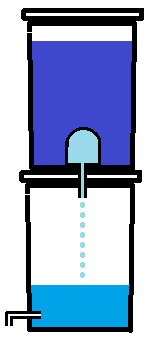- Procure buckets, ceramic filter, gaskets and nuts.
-
Find or buy electric drill and bits.
-
Drill 3/8" hole in centre of one lid.
-
Drill 3/8" hole in centre bottom of one bucket.
-
Drill 3/4" hole in side of other bucket, 1.5" from bottom.
-
Drill 1/16 air hole in side of both buckets just below lid.
-
Trim holes with a knife to remove burrs and to ensure roundness.
- Install spigot in 3/4" hole with a gasket both inside and
outside, tighten hexagonal nut inside, against gasket, finger
tight.
-
Install filter inside the bucket with a 5/8" hole at bottom with
gaskets both inside and outside, finger tighten wing nut beneath.
-
Put the lid with centre hole on the lower bucket with the spigot.
-
Put the lid without centre hole on the upper bucket with the filter.
-
Position the filter bucket atop the spigot bucket, such that the filter
spout passes through the hole in the lid of the lower bucket.
|


